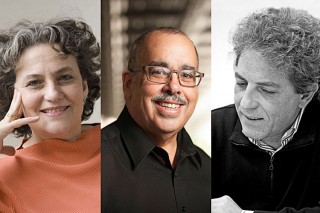Title

Betty Olivero (photo by Marina Berio), Roberto Sierra (center; photo courtesy of Cornell University Photography), and Stefano Gervasoni (right; photo by Paride Galeone) are among the composers whose works will be performed at the November 1 N.J.E. concert.
The huge number of performances each academic year produces enormous scheduling pressures on Juilliard’s performance spaces. In order to help solve the problems of conflicting needs, many entities, including the New Juilliard Ensemble, were asked to trim their activities a little. Nobody, however, wanted to diminish the opportunities for enthusiastic N.J.E. players or send a signal that the School’s commitment to new music was weakening. Provost and Dean Ara Guzelimian and I concluded that if N.J.E.’s November 1 concert used a smaller group and took place in Paul Hall, some pressure on the large venues could be eased without compromising the ensemble’s mission.
Body
Although I always enjoy working with the full-sized sinfonietta (about 15 people) and have a stack of scores now about 6 feet high and growing, there are many superb pieces for slightly smaller groups that can help N.J.E.’s players develop their skills and that are not getting performed. Arranging such a program for Paul Hall, however, is not without special challenges. Although its stage can accommodate the players, there isn’t a lot of room for set-up changes, which, in new music, often involve percussion instruments. On the big stages, Juilliard’s superb Orchestra and Ensemble Operations staff has allowed us to minimize delays; the Alice Tully crew also moves very quickly if staging plans are clearly formulated, and part of the trick is to set up the percussion instruments for all or almost all of each half of the concert beforehand or during intermission. At Paul Hall, however, the relative shallowness of the stage makes multiple setups very tricky.
One solution is to avoid having percussion in every piece. This noble idea unfortunately collides with the propensity of most composers to use percussion. Finding the right mixture of works is also a real challenge. I decided that the “anchor piece” for the November concert would be Roberto Sierra’s superb Concierto de Cámara, for wind quintet and string quartet. An immensely vigorous piece, it proved an excellent ending to a program when we played it at MoMA in 2012. (Of course, most of those players have since graduated.) To begin this program I reached back to another piece from that concert, Myth, by Korea’s eminent Sukhi Kang, for seven players including two percussion parts that use only three instruments. For the second work on the program, I wanted a piece by Stefano Gervasoni, whose wispy style is perfectly suited to Paul Hall and which would provide a wonderful contrast to the other pieces. He sent me the beautiful 2011 Froward (and yes, that’s the correct spelling) for seven players, which has only been performed once.
I had planned to end the first half with Presenze, an early but extremely dynamic and touching piece for 10 players by the Israeli composer Betty Olivero. She was perfectly content with the idea, but, knowing that Presenze had been done in New York and assuming that premieres are important, proposed a recent piece never done on this side of the Atlantic, Zimaar II, for soprano and ensemble, the style of which draws upon ancient Jewish musical traditions. I went to Brian Zeger, the artistic director of Juilliard’s Marcus Institute for Vocal Arts, and, impressed by the piece, he assured me that he had several singers who would be perfect for it.
That left only the spot after intermission. In going through my stash of scores, I came across a 1965 piece by the Polish composer Grazyna Bacewicz (1909-1969), one of the most important composers of an era when women were just beginning to find their way into the profession. (She had the advantage of being a star violinist.) I don’t recall Incrustations (1965) ever being done here, and the editor in chief of her publisher, Polskie Wydawnictwo Muzyczne, said that he is 90 percent sure that it hasn’t. It will certainly be new to most of the audience, and if anyone has heard it, another visit with the piece can only be a good thing. And it ensures a program with maximum variety that should be practical in Paul Hall.




